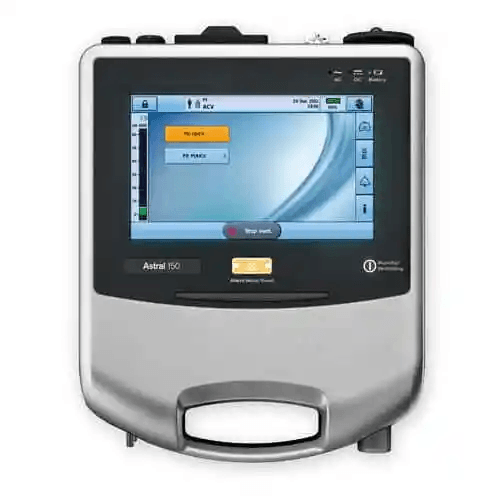Affordable Ventilators at Your Doorstep in Lahore, Karachi & Islamabad
Looking For Affordable Ventilators? Contact: 03196592050
Health Ease's Ventilator Line
What are Ventilators?
A ventilator is a life-saving medical device designed to assist or take over the breathing process for patients who are unable to breathe adequately on their own. Its primary purpose is to ensure that patients with breathing failure or difficulty breathing receive sufficient oxygen to their lungs and that carbon dioxide is appropriately removed from their bodies. This is crucial in medical settings for patients who, due to various conditions, cannot maintain the necessary levels of oxygenation and gas exchange to support bodily functions. Ventilators Lahore Karachi Islamabad, Pakistan.
Ventilators play a critical role in the care of patients with severe breathing conditions, such as acute breathing distress syndrome (ARDS), chronic obstructive pulmonary disease (COPD), or those undergoing major surgeries that affect breathing function. They are also pivotal in the treatment of patients affected by breathing illnesses like pneumonia and, as seen recently, those suffering from severe cases of COVID-19.
What is a ventilator?
There are two main types of ventilators: invasive and non-invasive. Invasive ventilators are used for patients who are critically ill and require endotracheal intubation or a tracheostomy, where a tube is inserted directly into the patient’s windpipe to deliver oxygen directly to the lungs. Non-invasive ventilation (NIV) is used for patients who need breathing support but do not require such an invasive approach. NIV methods include devices like CPAP (Continuous Positive Airway Pressure) and BiPAP (Bilevel Positive Airway Pressure) machines, which provide pressurized air through a mask to assist the patient’s breathing without the need for intubation.
Ventilators are used in various settings, primarily in Intensive Care Units (ICUs), where patients with the most severe breathing needs are treated. However, with advancements in technology, ventilators are also increasingly used in long-term care facilities and for home care, allowing patients to receive necessary breathing support outside the hospital setting. This has been especially beneficial for patients with chronic breathing conditions, enabling them to lead more normal lives.
The basic operational principles of a ventilator involve adjusting various parameters such as the volume of air delivered (tidal volume), the rate at which air is delivered (breathing rate), the concentration of oxygen in the air mixture (FiO2), and the pressure applied during inhalation and exhalation. The specific settings are meticulously adjusted by healthcare professionals based on the patient’s needs to ensure optimal support while minimizing potential harm, such as lung injury from overdistension.
How Do Ventilators Work?
Ventilators are life-saving machines designed to assist or replace the breathing process when a person is unable to breathe adequately on their own. They are crucial in intensive care units (ICUs) for patients with severe breathing conditions. Understanding how these machines work involves exploring the simulation of natural breathing processes, the mechanics behind the delivery of air to the lungs, and the critical role of personalized ventilation settings.
Mimicking Natural Breathing
At its core, a ventilator’s primary function is to replicate the natural process of breathing. Breathing naturally involves inhaling oxygen-rich air into the lungs and exhaling carbon dioxide-laden air out. Ventilators achieve this by:
Inhaling Phase (Inspiration): The machine pushes air (or a mixture of gases) into the lungs through a tube inserted into the patient’s airway. This phase imitates the muscle contraction of the diaphragm and chest muscles that expand the chest cavity and lower the pressure inside the lungs, causing air to flow in.
Exhaling Phase (Expiration): Unlike the active process of inhalation, exhalation on a ventilator is mostly passive. The machine stops delivering air, allowing the lungs and chest to return to their resting state, pushing the air out due to the elastic recoil properties of the chest and lungs.
Mechanics of Air Delivery
Ventilators can deliver air to the lungs in several ways, primarily focusing on two aspects: pressure control and volume control.
Pressure Control: The ventilator delivers air until a pre-set pressure is reached in the airway. This mode ensures a consistent pressure regardless of changes in lung compliance but can result in variable tidal volumes (the amount of air moved in or out during a single breath).
Volume Control: Here, the machine delivers a pre-set volume of air with each breath. This ensures that the patient receives a consistent amount of air, but the pressure may vary based on the resistance and compliance of the patient’s lungs.
The Importance of Ventilation Settings
Tailoring ventilation settings to the individual needs of patients is crucial for effective ventilation without causing harm. Key settings include:
Tidal Volume: The amount of air delivered with each breath. Setting this too high can lead to lung injury, while setting it too low may not adequately remove carbon dioxide.
Breathing Rate: The number of breaths delivered per minute. This needs to match the patient’s metabolic needs.
Oxygen Concentration: Adjusting the percentage of oxygen in the delivered air is vital, especially for patients with specific needs for higher or lower oxygen levels.
Positive End-Expiratory Pressure (PEEP): This is a low pressure applied at the end of the exhalation phase to keep the alveoli open, improving oxygenation and facilitating gas exchange.


